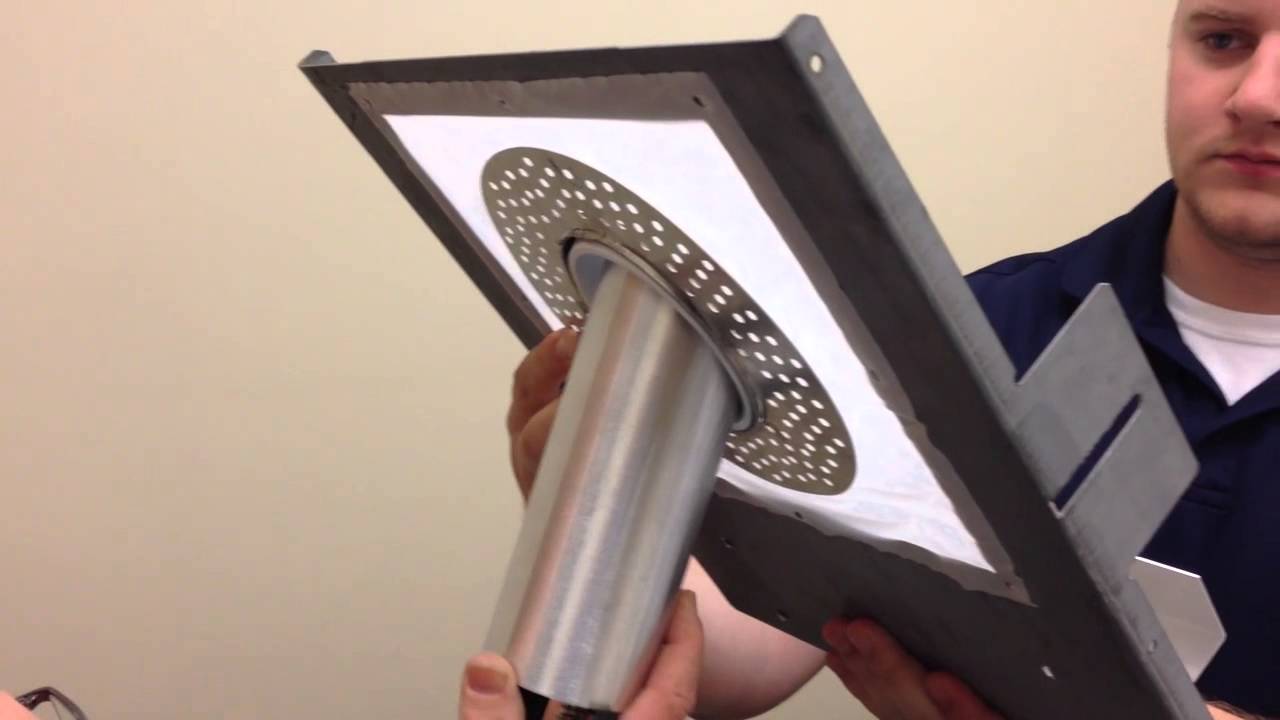Installing a range hood on a vaulted ceiling can be tricky, but it’s definitely possible with the right tools and techniques. First, you’ll need to purchase a range hood that is specifically designed for vaulted ceilings. Once you have your range hood, follow these steps to install it:
1) Use two people to lift the range hood into place. 2) Secure the range hood to the ceiling using screws or nails. 3) Connect the venting ductwork to the range hood.
4) Turn on the power and test out the range hood.
- Find the center point of your range hood and mark it on the ceiling
- Using a drill, create a hole at the marked spot
- Insert a mounting bracket into the hole and secure it with screws
- Hang the range hood on the bracket and secure it with more screws
- Connect the power supply to the range hood
- 6 Turn on the range hood to test it out
How to install a peninsula kitchen hood
Can You Put a Range Hood in a Vaulted Ceiling?
If you have a vaulted ceiling, you may be wondering if you can install a range hood. The answer is yes, but there are a few things to keep in mind. First, the height of the range hood should be at least 18 inches above the cooktop.
This will ensure that smoke and fumes are properly vented out of the kitchen. Second, make sure that the range hood has enough power to ventilate your kitchen. If it doesn’t, it won’t do a good job of removing smoke and fumes from the cooking area.
Third, consider installing an inline blower with your range hood. This will help to boost its performance and ensure that your kitchen is well-ventilated.
How Do You Mount a Range Hood on a Ceiling?
Most range hoods are designed to be mounted on the ceiling, above your stovetop. This is especially important for island stoves, where a wall-mounted range hood would block too much of the work area. Mounting a range hood on the ceiling also allows you to better capture rising smoke and steam, and send it out of the house more effectively.
To mount a range hood on the ceiling, you will need to first find the joists in your ceiling using a stud finder. Once you have located the joists, mark their location on the ceiling so you know where to drill your pilot holes. Next, use a drill to create pilot holes at each of your marks.
Be sure to use a bit that is smaller than your screws so that they can grip into the wood firmly.
Now it’s time to attach your range hood to the ceiling using screws and washers (or drywall anchors if needed). Start by holding up one end of the range hood against the ceiling and screwing it in place.
Then do the same with the other end. If your range hood has an adjustable length rod or telescoping chimney, extend it fully before attaching it at both ends as well. Finally, secure any loose parts or panels with screws or bolts as needed.
Does a Range Hood Have to Touch the Ceiling?
A range hood is a must-have for any kitchen, but you may be wondering whether it needs to touch the ceiling. The answer is no – a range hood can be installed without touching the ceiling, but there are some benefits to having it touch the ceiling.
One benefit of having a range hood touch the ceiling is that it helps to direct smoke and fumes up and away from your cooking area.
This is especially important if you do a lot of cooking with high heat, as it can help to prevent smoke and grease from damaging your walls or ceilings.
Another benefit of having a range hood touch the ceiling is that it can help to contain noise. If you have an exhaust fan that is mounted on the wall, it can cause quite a bit of noise – especially if it’s located near your bedroom or another living space.
Having the range hood touch the ceiling helps to muffle this noise somewhat, making it less likely to disturb you or your family members while you’re trying to sleep or relax.
Overall, there are both benefits and drawbacks to having a range hood touch the ceiling. It really comes down to personal preference and what works best for your particular kitchen layout.
If you’re not sure what will work best in your case, consult with a professional kitchen designer who can help you make the best decision for your space.
Should Range Hood Be at Eye Level?
There is no definitive answer to this question as it depends on a number of factors, such as the height of your ceilings, the size of your range hood, and personal preference. However, in general, it is advisable to install your range hood at eye level or slightly above so that smoke and grease are effectively removed from your cooking area.


Credit: www.reddit.com
Best Range Hood for Vaulted Ceiling
If you have a vaulted ceiling, you know that finding the right range hood can be a challenge. You want something that will look good and function well, but it seems like all the options out there are either too small or too big. Luckily, we’ve done the research for you and found the best range hood for vaulted ceilings.
The first thing you’ll want to consider is the size of your range hood. It needs to be big enough to cover your entire stovetop, but not so large that it overwhelzes your kitchen’s layout and dimensions to find the perfect-sized range hood
Range Hoods come in many different shapes, sizes, colors, and styles.
The most important factor when choosing a Range Hood is ensuring that it will properly ventilate your kitchen. There are three main types of ventilation: ducted, recirculating, and downdraft. Each type has its own set of pros and cons depending on your individual kitchen layout
Ducted: Pro – More effective at removing smoke and odors from cooking because they send contaminated air directly outside through an external vent. Con – Requires professional installation because ductwork must be added to connect the range hood to an external vent
Recirculating: Pro – Can be installed without any major renovations because they don’t require ductwork.
Con – Not as effective at removing smoke and odors because they filter and recirculate contaminated air back into the kitchen
Down Draft: Pro – Installed directly into the cooktop so they take up less space than other types of range hoods .
Proline Range Hood Installation Video
Are you looking for a Proline Range Hood Installation Video? Well, look no further! This blog post will provide you with all the information you need to know about installing a Proline range hood.
First, let’s talk about what a Proline range hood is. A Proline range hood is a type of ventilation system that helps remove smoke, odors, and heat from your kitchen. They are typically installed above your stove or cooktop and have a fan that pulls air through the unit and out of your kitchen.
Now that we know what a Proline range hood is, let’s talk about how to install one. The first thing you’ll need to do is measure the space above your stove or cooktop where you plan on installing the unit. Once you have those measurements, you’ll need to purchase a Proline range hood that fits those dimensions.
Once you have your new range hood, it’s time to start the installation process. The first step is to remove any old venting systems orRangeHoods that may be in place already. Next, you’ll want to follow the instructions provided by the manufacturer for properly installing your new unit.
This usually involves attaching brackets to the underside of your cabinets and then screwing the unit into place.
The last step in this process is wiring up your new Proline range hood accordingtothe manufacturer’s instructions. Once everything is properly installed and wired, turn on your new rangehood and enjoy improved ventilation in your kitchen!
Should Range Hood Go to Ceiling
When it comes to range hoods, there are two main schools of thought: those who believe the range hood should go to the ceiling, and those who believe it should stop at the cabinets. So which is right?
There are a few things to consider when making your decision.
First, think about the overall look you want for your kitchen. If you have high ceilings and want a more dramatic look, then a ceiling-mounted range hood might be the way to go. On the other hand, if you have lower ceilings or prefer a more understated look, then a hood that stops at the cabinets might be better suited for your space.
Another thing to keep in mind is functionality. A ceiling-mounted range hood will do a better job of clearing smoke and odors from your cooking area than one that stops at the cabinets. This is because it will have more air flow and can ventilate your space more effectively.
However, if you don’t do a lot of cooking that generates a lot of smoke and odor, then a less powerful range hood that stops at the cabinets may be just fine for your needs.
Ultimately, there is no right or wrong answer when it comes to deciding whether a range hood should go to the ceiling or stop at the cabinets. It’s simply a matter of personal preference and what will work best for your specific kitchen space.
Conclusion
Installing a range hood on a vaulted ceiling may seem like a daunting task, but it’s actually quite simple. First, you’ll need to purchase a range hood that is the correct size for your stove. Next, mark the center of the hood on the ceiling using a pencil or chalk.
Then, use a drill to create pilot holes for the screws. Finally, screw the range hood into place and turn it on.

